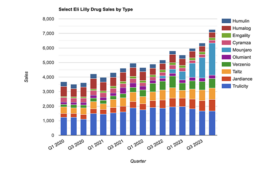Novartis brolucizumab (RTH258) demonstrates superiority versus aflibercept in key secondary endpoint measures of disease activity in nAMD, a leading cause of blindness.
Novartis has announced further positive results from two Phase III studies of brolucizumab versus aflibercept. Results showed non-inferiority in primary endpoint, superiority in key retinal health outcomes, and long-lasting effect in patients with neovascular age-related macular degeneration (nAMD), a leading cause of blindness. The results of the head-to-head trials, HAWK and HARRIER, were presented at the American Academy of Ophthalmology (AAO) 2017 Annual Meeting1.
In neovascular AMD, abnormal blood vessels leak fluid into the eye, ultimately causing damage and blindness2. At week 16, relative to aflibercept, 35 percent fewer brolucizumab 6 mg patients showed presence of IRF and/or SRF in HAWK, and 33 percent fewer in HARRIER (P<0.0001 for both)1.
Again at week 48, relative to aflibercept, 31 percent fewer patients on brolucizumab 6 mg had intra-retinal fluid (IRF) and/or sub-retinal fluid (SRF) in HAWK, and 41 percent fewer in HARRIER (P<0.0001 for both)1. The absence of fluid for patients in the brolucizumab arm suggests the potential for a long-lasting effect and decreased treatment need.
Additionally, brolucizumab 6 mg patients demonstrated superior reductions in central subfield thickness (CST)1. In nAMD, an elevated CST — as measured by optical coherence tomography (OCT) — is a key indicator of abnormal fluid accumulation in the retina3. Significantly improved CST reductions were evident at week 16 (P=0.0016 in HAWK and P<0.0001 in HARRIER) and at week 48 (P=0.0023 and P<0.0001, respectively)1.
Brolucizumab met the primary efficacy endpoint of noninferiority to aflibercept in mean change in best-corrected visual acuity (BCVA) from baseline to week 48 in both trials1. These results were achieved while a majority of brolucizumab patients — 57 percent in HAWK and 52 percent in HARRIER — were maintained on a q12w dosing interval immediately following the loading phase through week 481.
“HAWK and HARRIER demonstrated that brolucizumab has the potential to positively impact disease management and provide long-lasting treatment effect,” said Dr. Pravin U. Dugel, managing partner, Retinal Consultants of Arizona; clinical professor, Roski Eye Institute, Keck School of Medicine, University of Southern California; and principal investigator of both trials.
“HAWK and HARRIER showed that brolucizumab outperformed aflibercept on disease activity assessments, including key measures of disease progression seen on OCT, which forms the basis of a clinician’s treatment decisions. Importantly, improvements in these key OCT measures were seen as early as week 16 and maintained at week 48, with a majority of brolucizumab patients on a 12-week treatment interval.”
Frequent injections into the eye, a standard requirement for nAMD therapies, can be a significant hardship for patients and burden on caregivers4,5. Brolucizumab is the first and only anti-vascular endothelial growth factor (anti-VEGF) treatment for nAMD to demonstrate robust visual gains with a majority of patients maintained on a less-frequent 12-week (q12) treatment interval immediately following the loading phase in randomized clinical trials1.
“Having delivered on our non-inferiority endpoint with a majority of patients on a q12 week interval, we’re truly excited to share these data showing that brolucizumab clearly improves key anatomical outcomes that are biomarkers of disease,” said Vas Narasimhan, global head, drug development and chief medical officer, Novartis. “Brolucizumab represents a major scientific and clinical advancement for patients, caregivers and retina specialists around the world.”
With brolucizumab, significantly fewer patients had active disease at week 16 in a matched head-to-head comparison. Active disease was observed in 23.5 percent of brolucizumab 6 mg patients versus 33.5 percent of aflibercept patients in HAWK, and in 21.9 percent of brolucizumab patients versus 31.4 percent of aflibercept patients in HARRIER (P=0.0022 for both)1.
Brolucizumab safety was comparable to aflibercept with the overall incidence of adverse events balanced across all treatment groups in both studies1. The most frequent ocular adverse events (greater than 5 perent of patients in any treatment arm) for brolucizumab 3 mg, 6 mg and aflibercept, respectively, in HAWK were reduced visual acuity (8.7 percent, 6.9 percent and 8.9 percent), conjunctival hemorrhage (8.4 percent, 6.4 percent and 5.6 percent), vitreous floaters (6.7 percent, 5.0 percent and 3.1 percent) and eye pain (5.9 percent, 4.4 percent and 4.2 percent)6.
The incidences of these events for brolucizumab 6 mg and aflibercept, respectively, in HARRIER were reduced visual acuity (5.9 percent and 6.2 percent), conjunctival hemorrhage (1.9 percent and 3.3 percent), vitreous floaters (3.0 percent and 0.8 percent) and eye pain (2.7 percent and 3.3percent)6.
The most frequent non-ocular adverse events were typical of those reported in an nAMD population; there were no notable differences between arms6. The incidence of arterial thrombotic events (ATE) was 3.9 percent, 2.5 percent and 5.5 percent (brolucizimab 3 mg, brolucizumab 6 mg and aflibercept respectively) in HAWK and 1.6 percent and 1.1 percent (brolucizumab 6 mg and aflibercept, respectively) in HARRIER1.
______________________________________________________
References:
1 Dugel P, et al. HAWK & HARRIER: 48-week results of 2 multi-centered, randomized, double-masked trials of brolucizumab versus aflibercept for neovascular AMD. Presented at: The American Academy of Ophthalmology 2017 Annual Meeting on November 10, 2017, New Orleans.
2 NHS Choices. Macular Degeneration. Available at https://www.nhs.uk/Conditions/Macular-degeneration/Pages/Introduction.aspx (link is external). Accessed November 2017.
3 Kang SW, et al. The correlation between fluorescein angiographic and optical coherence tomographic features in clinically significant diabetic macular edema. Am J Ophthalmol 2004;137(2):313-322.
4 Mantel I. Optimizing the Anti-VEGF Treatment Strategy for Neovascular Age-Related Macular Degeneration: From Clinical Trials to Real-Life Requirements. Translational Vision Science & Technology. 2015;4(3):6.
5 Gohil R, et al. Caregiver Burden in Patients Receiving Ranibizumab Therapy for Neovascular Age Related Macular Degeneration. PLoS ONE. 2015;10(6):e0129361.
6 Data on file.
(Source: Novartis)
Filed Under: Drug Discovery




